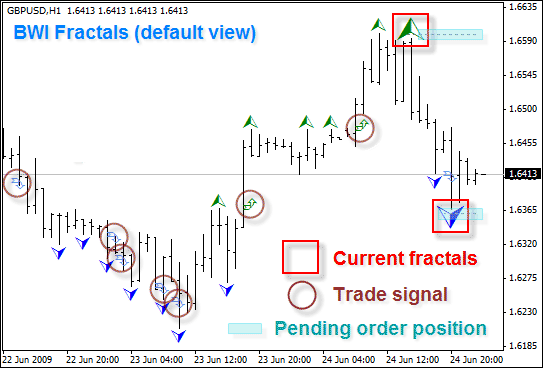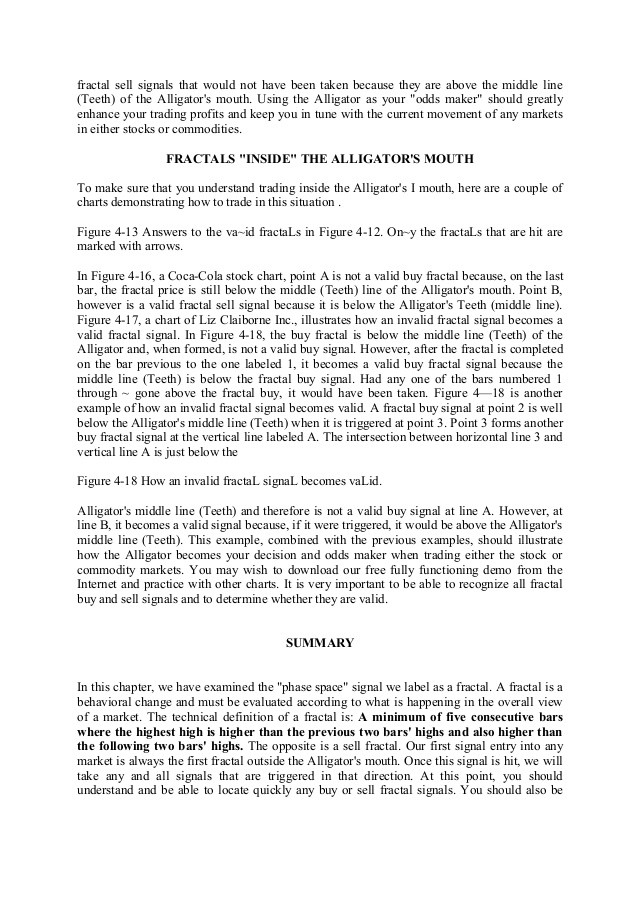Bill Williams Analysis Fractals and the Alligator Indicators Traders Laboratory
Post on: 16 Март, 2015 No Comment

The trading theories developed by Bill Williams combine various aspects of Chaos Theory with the general tendencies seen in trading psychology to determine the ways these factors influence the trading markets. Broadly speaking, Williams’ central suggestion is that the ability to accurately forecast the trading markets comes as a result of the behaviors that are typically expressed by human psychology, and that it is possible for any trader to post consistently successful results the hidden determinism of market events (which, on the surface, might appear to be random) are ultimately uncovered.
Where Williams’ techniques differ from the wider majority seen in the market is in the idea that technical analysis (and even fundamental analysis) is unable to guarantee consistently accurate price forecasting and profitable trading results because these approaches fail to the broader workings at work in the “real” market. Williams’ work suggests that most traders ultimately lose because there is a general tendency to rely on different (and potentially conflicting) forms of analysis. Williams’ conclusions suggest that all of these approaches are useless when dealing with models that are nonlinear and dynamic (ie. the financial markets).
Trades with Market Dimensions
At this stage, it should be clear that the ideas of Bill Williams work heavily off of the concept that trading in the financial markets is largely a game of psychology. But, in addition to this, it is also important to have a unique understanding of the way markets are structured. For Williams, this means breaking down a market to its core sections, which he called Dimensions. These include the Phase Space (Fractals), Phase Energy (Price Momentum), Phase Force (price acceleration and deceleration), Zones (Phase Force and Energy in conjunction), and the Balance Line.
Using the Williams method, all trading signals can be disregarded until the early Fractal dimension gives an indication of future price direction. These Fractal signals allow traders to open a small position and then to place additional positions in the same price direction when signals from the other structural dimensions are seen. Traders should limit position sizes accordingly, as it should be understood that new trading signals will develop after the early trade is placed.
When looking to close a position, profit targets are often calculated in relation to the overall movements that are seen in the dominant trend. A good rule of thumb suggests that these targets should be equal to roughly 10% of the most recent impulsive wave. Waiting longer than this can create disruptions in the Williams method because the calculations that go into defining the Fractal areas are highly sensitive to changes in price.
The Gator and Alligator Indicators
Two of Bill Williams’ most famous indicators are the Gator and the Alligator, which, he explains, will act like a homing device which tells traders the most likely direction prices will travel. The Alligator is designed to show traders which trend is really present in the market and will keep traders away from range bound trading. The indicator itself is composed of three individual balance lines:
- The Alligator Jaw is a 13-interval MA that is based on the midpoint of the price interval [(High+Low)/2]. In the attached chart, this is the blue line and is offset 8 bars forward.
- The Alligator Teeth is an 8-interval MA that is based on the midpoint of the price interval [(High+Low)/2]. This is the red line and is offset 5 bars forward.
- The Alligator Lips are a 5-interval MA that is based on the midpoint of the price interval [(High+Low)/2]. This is shown in the green line and is offset 2 bars forward.
When the three lines of the Alligator are intertwined, the Alligator is dormant, which is suggestive of range bound market activity. As is typical with consolidation periods, this can only last for so long, and the longer this is seen, the greater the potential price that prices will explode later. Looking at the actual indicator, this occurs when there is a divergence between the Balance Lines. After this is seen (and the following explosive price move unfolds), wait for the Alligator to show a dormant signal once again before exiting the position.
Determining Trend Direction

When the Alligator is sending its signals, there are trending forces at work in the market (either an uptrend or a downtrend). Here are the general rules for the trend indicator:
- Prices above the Alligator lines indicate an uptrend
- Prices below the Alligator lines indicate a downtrend
- Price activity outside the Alligator lines suggest the current wave is impulsive (in Elliott Wave Analysis)
- Price activity inside the Alligator lines suggest the current wave is corrective (in Elliott Wave Analysis)
A Look at the Williams Gator Oscillator
The Bill Williams Gator Oscillator is an expression of the degree to which the Balance lines are showing convergence or divergence. The visual display for the oscillator shows two histograms, which can be seen in the second attached chart. When the histogram is in positive territory, we can see the difference between the Alligator Jaws and Teeth (which is the Red and Blue lines). When the histogram is in negative territory, we can see the difference between the Alligator Teeth and Lips (which is the Green and Red lines).
The next element to watch is the changing colors of the bars themselves. Red colors are seen in the histogram when the histogram bar is lower than the previous interval. Green colors are seen in the histogram when the histogram bar is above the previous interval. The Gator shows convergence (intertwining in the Balance Lines) when the
Alligator is breaking from indications of range bound activity and this can help when looking to identify trends.
Bill Williams’ Use of Fractals
One of the central maxims in the Bill Williams approach holds that positions should not be established until the initial Fractal signal is generated. Until this happens, all other indicator readings can be ignored. When dealing with Fractals, buy signals are generated when five consecutive bars unfold in a set series. Bullish turn arounds are seen when patterns show the lowest low of the 5 bar series, along with two higher lows on the right and left side. When a buy fractal occurs above the Alligator Teeth (which is the Red line), stop losses can be set just above the high of the upward Fractal.
Sell signals are generated when five consecutive bars unfold in a reverse set series. Bearish turn arounds are seen when patterns show the lowest low of the 5 bar series, along with two higher lows on the right and left side. When a buy fractal occurs above the Alligator Teeth (which is the Red line), buy stops can be set just above the high of the upward Fractal. When a sell fractal occurs below the Alligator Teeth, sell stops can be set just below the low of the sell Fractal. It should also be remembered that Fractal buy signals are not considered valid if they are seen below the Alligator Teeth. Similarly,
Fractal sell signals are not considered valid if they are seen above the Alligator Teeth.
Fractal signals will be considered valid until the pending trading orders are triggered or until a newer Fractal (showing the same price direction) become apparent. If this second scenario occurs, the initial signal is disregarded (and the order for that signal should be removed).
In Williams’ analysis, Fractals are, in some sense, the “advance guard” as this is what makes up the first dimension in markets. We would need to see a breakout of the initial Fractal signal in order to consider valid the other signals that are generated by the system indicators. Later, signals might develop in later Fractal formations (in the same direction), and these can be used as a signal to add on to the position.














